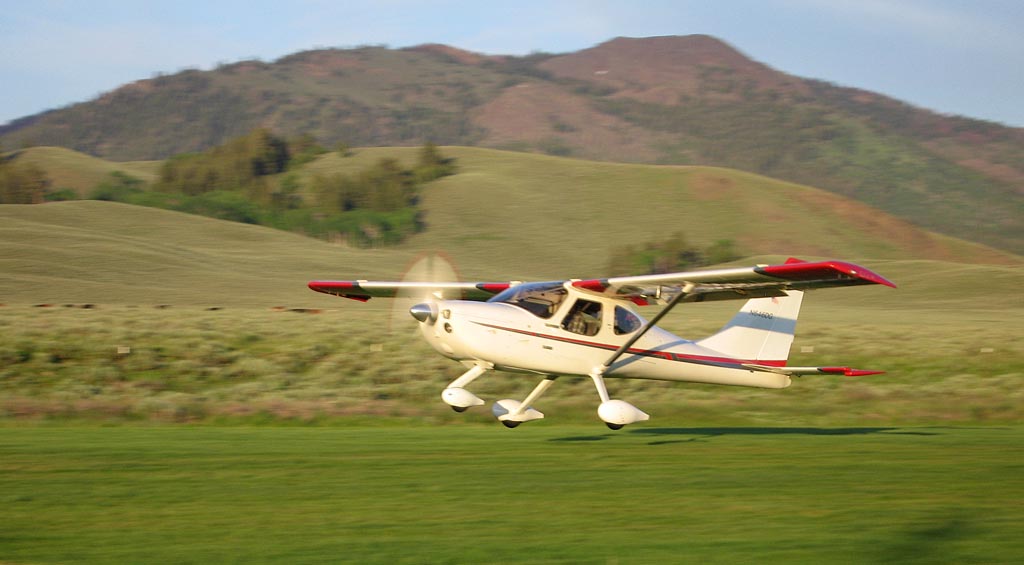
When flying at airshows, it’s not uncommon to have many aircraft of various approach speeds all headed for the same or parallel runways at the same time. One of the delights in flying the GlaStar is its ability to match fast or slow approach speeds, while giving excellent visibility. Knowing the GlaStar can adjust its speed quickly, fly slow and land in very short distances safely, even in crosswinds, allows us to adjust our spacing for almost any traffic. While this may not be your idea of fun its proven control is something you can learn and count on when the chips are down (or the wind and traffic are up).
Again, please study Stoddard Hamilton’s highly rated Owner’s Manual on the GlaStar. Normal landings are covered on page 34, section 4-13.3. Since a good approach simplifies the landing procedure, be sure and also read section 4-13.2 about the Approach. First, turn your fuel selector to the proper tank, turn on fuel boost (if injected) or pull on carb heat and push in mixture (unless landing at higher altitudes). If traffic is not a factor I plan a close pattern. Here’s a safety note. Whenever I am in the pattern, I want to be close and high enough to glide to a safe landing if the engine quits. Why put your great airplane in the trees just short of a runway because you are too low to make the field if power is lost? If traffic prohibits a close pattern, then I do not descend below pattern altitude through downwind and if necessary remain high even on base. On long runways, I plan to land where a normal rollout will put me at the taxi turnout I wish to use.
Upon entering downwind, I pull the power to idle, slow to 65 knots, put the flaps half down, reapply sufficient power to maintain a level pattern altitude and trim the elevator for hands-off flight. The flaps go down a lot easier if I wait till I’m at 65 knots. Half flaps cause the nose to be lower for better visibility, and by trimming the airplane to fly level, I have one less thing to think about. I hold 65 throughout the approach, removing power and pushing the prop control forward at a point where power will no longer be required to land at the location on the runway I’ve chosen. Turning final I will apply full flaps, readjust the trim and continue down final at 65. If crosswinds exist then I “crab” the airplane on final until I start the flare when I also lower the wing into the wind and apply opposite rudder to keep the airplane going straight down the centerline.
Get close to the runway, five feet or so, and raise the nose only an inch or two. Never raise the nose so high it blocks the runway. For directional control, I look a few hundred feet down the runway. At about five feet above the runway, 65 knots and no power, the GlaStar will respond very well to a slight flare. The point is to get as close to the ground as possible without touching any tires. As the flare starts, the descent will slow and the speed will drop to 60 knots. Here is when I roll the main tires (or one main tire if a crosswind) on the runway using elevator control. I do not touch down much slower than 55 to 60 knots except for three-point, full-stall landings in the taildragger.
If you are in the trike, hold the nose wheel an inch or so off the runway until the speed slows to where it wants to come down on its own. If you are in the taildragger then upon touchdown push the stick forward to hold the tail at almost level flight attitude and gradually continue pushing the stick forward, “flying” the tail at flight attitude until the tail wants to come down. Once you have wheel landings down, gradually slow the taildragger by continuing the flare just above the runway until reaching a three-point, full-stall touchdown. Always hold the stick full back upon touchdown in a three point so the tail can’t bounce and to obtain positive steering. If it’s windy, then removal of flaps will “plant” the airplane on the ground for better braking. Applying brakes evenly or appropriate to the crosswind will bring the GlaStar to a safe speed for taxiing.
Tim Johnson’s articles are his own perspective and reflect over 1,000 hours of safely flying the prototype GlaStar in demonstration, cross-country, and air-show flights. Your experience, training, GlaStar airplane, and local situations may require different procedures. Be safe! Never attempt something just because someone else did it! The current GlaStar Owner’s Manual and current FAA and/or local regulations are your overriding guides. Airspeeds used are KIAS (indicated airspeed in knots).



